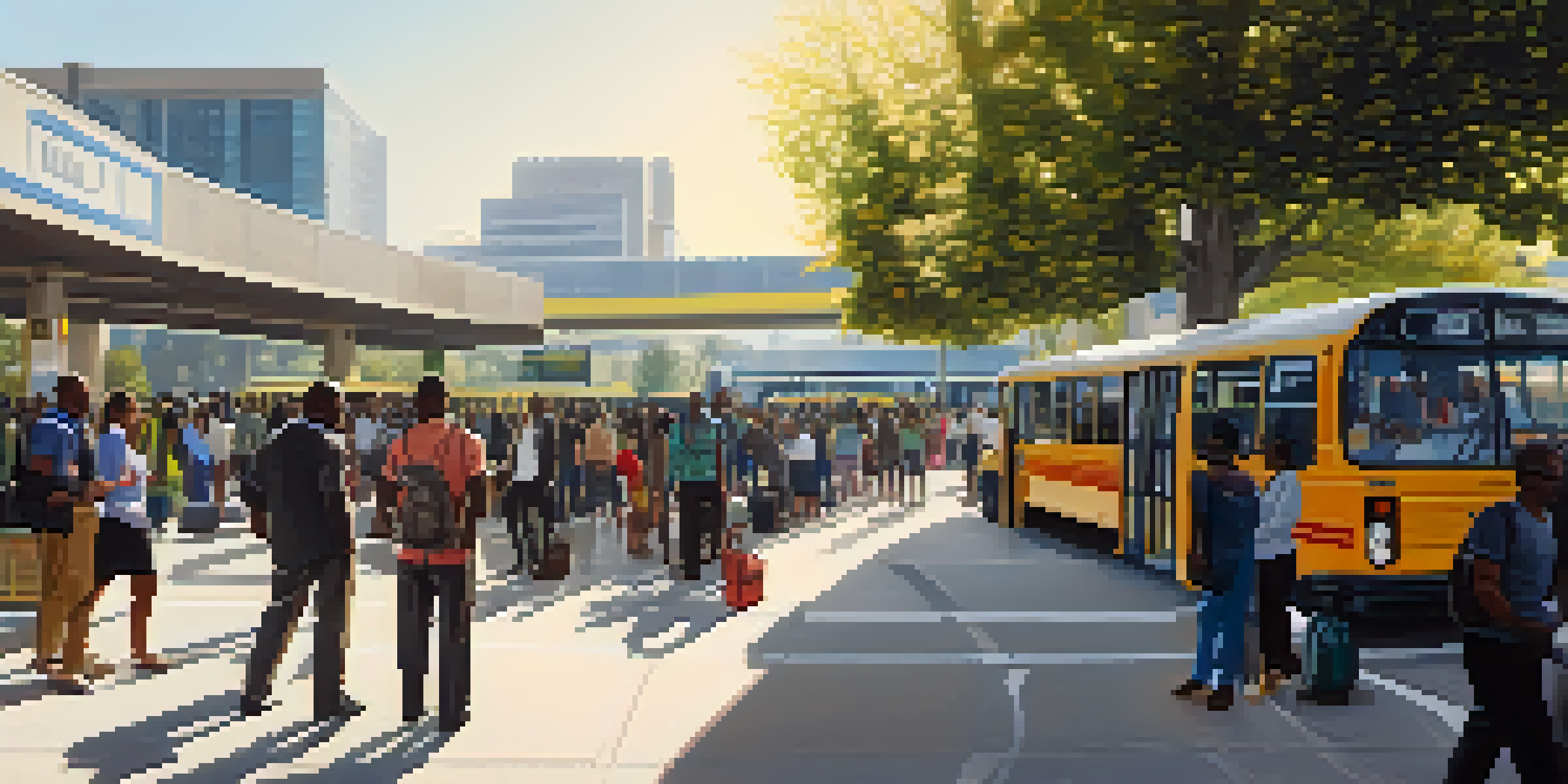Understanding the Public Transportation Issues in Compton Today

Overview of Compton's Public Transportation System
Compton, a city with a rich history in Los Angeles County, faces unique challenges in its public transportation system. The existing infrastructure includes bus services and limited rail options, which are crucial for residents to access jobs, education, and essential services. However, many individuals still rely on personal vehicles due to inadequate coverage and frequency of public transport. Understanding these dynamics is essential to grasp the broader issues at play.
Public transportation is a lifeline for communities, connecting individuals to opportunities and resources.
The Los Angeles County Metropolitan Transportation Authority (Metro) operates several bus lines in Compton, but many residents report that these routes do not adequately serve their needs. For instance, routes may not connect seamlessly to employment centers or educational institutions, leaving some commuters stranded. This lack of connectivity can create significant barriers for those who depend on public transport to get to work or school.
Moreover, the perception of safety on public transportation can deter potential users. Incidents of crime or vandalism can lead to a lack of trust in the system, prompting residents to opt for less sustainable transportation methods. Therefore, addressing safety concerns is vital for encouraging more people to utilize public transit.
Challenges Facing Compton's Transit System
One of the primary challenges is funding. Public transit systems often rely on government budgets, which can fluctuate based on economic conditions and political priorities. In Compton, this has led to insufficient resources for maintenance and expansion of services. As a result, the existing infrastructure struggles to keep pace with the needs of a growing population.

Additionally, the geographical layout of Compton complicates transit planning. The city is characterized by a mix of residential neighborhoods and commercial areas, which can make it difficult to design routes that effectively serve all residents. Many bus routes have long wait times or limited schedules, particularly during off-peak hours, which can discourage people from relying on public transport.
Public Transport Challenges in Compton
Compton's public transportation system struggles with inadequate funding, limited route coverage, and safety concerns, hindering residents' access to jobs and services.
Finally, a lack of public awareness about available transit options contributes to the problem. Many residents may not be fully informed about the services that do exist or how to navigate the system. This gap in knowledge can lead to underutilization of transit services, perpetuating the cycle of dependency on personal vehicles.
Impact of Public Transport on Compton's Community
Public transportation plays a critical role in shaping the community's social and economic landscape. When effective, it connects individuals to job opportunities, reduces traffic congestion, and lowers greenhouse gas emissions. However, the current state of public transport in Compton can hinder these potential benefits, leading to longer commute times and increased air pollution.
The best way to predict the future is to create it.
Moreover, limited access to public transport can exacerbate economic inequalities. Residents without reliable transit options may struggle to find stable employment or access necessary services, creating a cycle of poverty. This situation can impact the overall well-being of the community, as access to education and healthcare becomes more challenging.
The interconnectedness of public transport and community development highlights the importance of addressing these transportation issues. By improving transit options, Compton can enhance its residents' quality of life, promote economic growth, and foster a more sustainable environment.
Recent Developments and Initiatives
In recent years, there have been efforts to improve public transportation in Compton. Local government and community organizations have begun advocating for increased funding and better services. For example, some initiatives focus on improving bus routes, increasing frequency, and enhancing safety measures on public transit.
Additionally, community meetings and surveys have been conducted to gather input from residents about their transportation needs. This grassroots approach empowers individuals to voice their concerns and contribute to the planning process. By involving the community, initiatives can be more tailored to address specific issues faced by residents.
Community Engagement is Essential
Involving residents in discussions about their transit experiences can lead to better solutions and increased support for public transportation initiatives in Compton.
Moreover, partnerships with regional transportation agencies are being explored to expand service options. Collaborations with organizations like Metro can provide additional resources and expertise to help address the challenges facing Compton's transit system.
The Role of Technology in Public Transport
Technology has the potential to revolutionize public transportation in Compton. Mobile apps that provide real-time tracking of buses can help commuters plan their trips more effectively. This kind of transparency can lead to increased usage, as residents feel more informed and confident about their travel options.
Moreover, technology can enhance safety features on public transport. Surveillance systems and better communication tools can create a safer environment for riders, addressing one of the primary concerns deterring potential users. By leveraging these advancements, public transit can become a more attractive option for everyone in Compton.
Additionally, data analytics can play a crucial role in improving transit services. By analyzing ridership patterns and identifying peak travel times, transit authorities can make informed decisions about service adjustments. This data-driven approach helps ensure that resources are allocated efficiently and effectively.
Community Involvement in Transit Solutions
Community involvement is essential in finding solutions to Compton's public transportation issues. Engaging residents in discussions about their transit experiences can yield invaluable insights and foster a sense of ownership over the transit system. When individuals feel their voices are heard, they are more likely to support initiatives aimed at improving services.
Local advocacy groups and non-profits play a vital role in this process by organizing events and campaigns that raise awareness about transportation issues. These organizations can connect residents with decision-makers, ensuring that community needs are prioritized in planning efforts. By working together, residents and advocates can push for changes that directly benefit the community.
Technology Can Transform Transit
Utilizing technology such as real-time tracking apps and data analytics can enhance the safety, efficiency, and overall appeal of public transport in Compton.
Furthermore, educational programs can help residents understand how to navigate the public transit system. Workshops and informational sessions can empower users with knowledge about routes, schedules, and safety protocols, ultimately increasing public transport usage and community engagement.
Looking Ahead: The Future of Public Transportation in Compton
As Compton continues to grow, the future of public transportation is a topic of increasing importance. With the right investments and community involvement, the potential for enhancing the transit system is significant. This evolution could lead to a more connected, efficient, and sustainable city where residents can thrive without relying solely on personal vehicles.
Future plans may include expanding bus routes, introducing more frequent services, and even exploring the possibility of light rail options. Such developments would not only provide better access to essential services but also stimulate economic growth by attracting businesses and residents alike.

Ultimately, the success of these efforts hinges on collaboration among city officials, transit authorities, and the community. By working together, Compton can create a public transportation system that meets the needs of its residents and contributes to a brighter, more sustainable future.